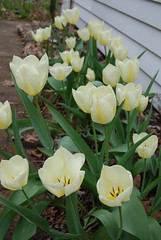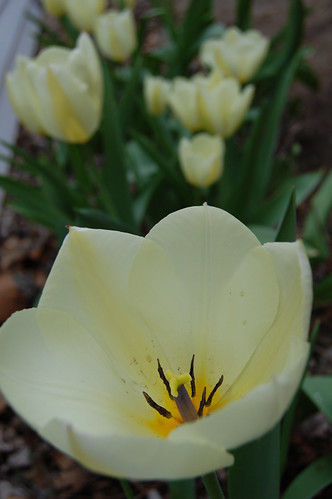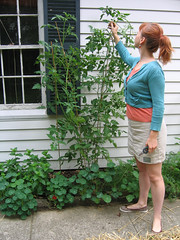Perennial Tulip
Gardeners are advised to treat tulips as annuals. Despite their association with the soggy Netherlands, tulips are native to the dry, mountainous regions of central Asia. They need cold winters, wet springs, and dry summers to perform well year after year. Most gardeners can’t (or won’t) provide these conditions, so the plants decline after a year or so. Tulip breeders offer varieties they claim are perennial, but are they really? (And, wouldn’t it be counter to the tulip breeder’s interests to produce a tulip that perennializes in the garden setting?)
 I’ve either got one of those new-fangled perennial tulips or special conditions in my garage bed because these tulips are going strong on their third year! They’ve received no extra care. I haven’t fertilized them. They got pretty wet this summer as I irrigated the nearby tomato bushes. You want to know what type of tulip they are, right?
I’ve either got one of those new-fangled perennial tulips or special conditions in my garage bed because these tulips are going strong on their third year! They’ve received no extra care. I haven’t fertilized them. They got pretty wet this summer as I irrigated the nearby tomato bushes. You want to know what type of tulip they are, right?
I wish I knew! They came free with some bulb order. Ah, the irony, to have a tulip that appears to perennialize and not know how to get more.

 I’ve either got one of those new-fangled perennial tulips or special conditions in my garage bed because these tulips are going strong on their third year! They’ve received no extra care. I haven’t fertilized them. They got pretty wet this summer as I irrigated the nearby tomato bushes. You want to know what type of tulip they are, right?
I’ve either got one of those new-fangled perennial tulips or special conditions in my garage bed because these tulips are going strong on their third year! They’ve received no extra care. I haven’t fertilized them. They got pretty wet this summer as I irrigated the nearby tomato bushes. You want to know what type of tulip they are, right?I wish I knew! They came free with some bulb order. Ah, the irony, to have a tulip that appears to perennialize and not know how to get more.

Labels: garage bed, tulips



